Related Research Articles

The Antarctic Treaty and related agreements, collectively known as the Antarctic Treaty System (ATS), regulate international relations with respect to Antarctica, Earth's only continent without a native human population. It was the first arms control agreement established during the Cold War, designating the continent as a scientific preserve, establishing freedom of scientific investigation, and banning military activity; for the purposes of the treaty system, Antarctica is defined as all the land and ice shelves south of 60°S latitude. Since September 2004, the Antarctic Treaty Secretariat, which implements the treaty system, is headquartered in Buenos Aires, Argentina.

The Antarctic is a polar region around Earth's South Pole, opposite the Arctic region around the North Pole.
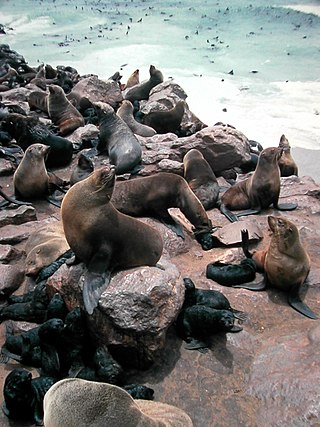
Fur seals are any of nine species of pinnipeds belonging to the subfamily Arctocephalinae in the family Otariidae. They are much more closely related to sea lions than true seals, and share with them external ears (pinnae), relatively long and muscular foreflippers, and the ability to walk on all fours. They are marked by their dense underfur, which made them a long-time object of commercial hunting. Eight species belong to the genus Arctocephalus and are found primarily in the Southern Hemisphere, while a ninth species also sometimes called fur seal, the Northern fur seal, belongs to a different genus and inhabits the North Pacific. The fur seals in Arctocephalus are more closely related to sea lions than they are to the Northern fur seal, but all three groups are more closely related to each other than they are to true seals.
The Protocol on Environmental Protection to the Antarctic Treaty, also known as the Madrid Protocol, is a complementary legal instrument to the Antarctic Treaty signed in Madrid on October 4, 1991. It entered into force on January 14, 1998.

An eared seal, otariid, or otary is any member of the marine mammal family Otariidae, one of three groupings of pinnipeds. They comprise 15 extant species in seven genera and are commonly known either as sea lions or fur seals, distinct from true seals (phocids) and the walrus (odobenids). Otariids are adapted to a semiaquatic lifestyle, feeding and migrating in the water, but breeding and resting on land or ice. They reside in subpolar, temperate, and equatorial waters throughout the Pacific and Southern Oceans, the southern Indian, and Atlantic Oceans. They are conspicuously absent in the north Atlantic.
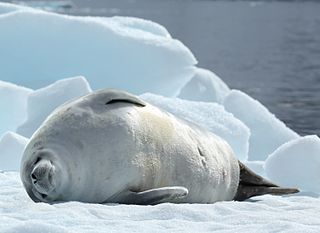
The crabeater seal, also known as the krill-eater seal, is a true seal with a circumpolar distribution around the coast of Antarctica. They are medium- to large-sized, relatively slender and pale-colored, found primarily on the free-floating pack ice that extends seasonally out from the Antarctic coast, which they use as a platform for resting, mating, social aggregation and accessing their prey. They are by far the most abundant seal species in the world. While population estimates are uncertain, there are at least 7 million and possibly as many as 75 million individuals. This success of this species is due to its specialized predation on the abundant Antarctic krill of the Southern Ocean, for which it has uniquely adapted, sieve-like tooth structure. Indeed, its scientific name, translated as "lobe-toothed (lobodon) crab eater (carcinophaga)", refers specifically to the finely lobed teeth adapted to filtering their small crustacean prey. Despite its common name, crabeater seals do not eat crabs. As well as being an important krill predator, the crabeater seal's pups are an important component of the diet of leopard seals (H. leptonyx). They are the only member of the genus Lobodon.

The leopard seal, also referred to as the sea leopard, is the second largest species of seal in the Antarctic. Its only natural predator is the orca. It feeds on a wide range of prey including cephalopods, other pinnipeds, krill, fish, and birds, particularly penguins. It is the only species in the genus Hydrurga. Its closest relatives are the Ross seal, the crabeater seal and the Weddell seal, which together are known as the tribe of Lobodontini seals. The name hydrurga means "water worker" and leptonyx is the Greek for "thin-clawed".
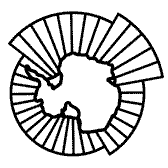
The Convention on the Conservation of Antarctic Marine Living Resources, also known as the Commission for the Conservation of Antarctic Marine Living Resources, and CCAMLR, is part of the Antarctic Treaty System.

The Agreed Measures for the Conservation of Antarctic Fauna and Flora is a set of environmental protection measures which were accepted at the third Antarctic Treaty Consultative Meeting in Brussels in 1964. The Agreed Measures were formally in force as part of the Antarctic Treaty System from 1982 to 2011, when they were withdrawn as the principles were now entirely superseded by later agreements such as the 1991 Protocol on Environmental Protection to the Antarctic Treaty. The Agreed Measures were adopted in order to further international collaboration within the administration of the Antarctic Treaty System and promote the protection of natural Antarctic ecological systems while enabling scientific study and exploration.

The Antarctic toothfish, also known as the Antarctic cod, is a large, black or brown fish found in very cold (subzero) waters of the Southern Ocean near Antarctica. It is the largest fish in the Southern Ocean, feeding on shrimp and smaller fish, and preyed on by whales, orcas, and seals. It is caught for food and marketed as Chilean sea bass together with its sister species, the more northerly Patagonian toothfish. Often mistakenly called "Antarctic cod", the Antarctic toothfish belongs to the notothen family (Nototheniidae), a family of fish genera that are abundant near Antarctica.

The Antarctic fur seal is one of eight seals in the genus Arctocephalus, and one of nine fur seals in the subfamily Arctocephalinae. Despite what its name suggests, the Antarctic fur seal is mostly distributed in Subantarctic islands and its scientific name is thought to have come from the German vessel SMS Gazelle, which was the first to collect specimens of this species from Kerguelen Islands.

The genus Arctocephalus consists of the southern fur seals. Arctocephalus translates to "bear head."

The subantarctic fur seal is a species of arctocephaline found in the southern parts of the Indian, Pacific, and Atlantic Oceans. It was first described by Gray in 1872 from a specimen recovered in northern Australia—hence the inappropriate specific name tropicalis.

The South American fur seal breeds on the coasts of Peru, Chile, the Falkland Islands, Argentina, Uruguay and Brazil. The total population is around 250,000. However, population counts are sparse and outdated. Although Uruguay has long been considered to be the largest population of South American fur seals, recent census data indicates that the largest breeding population of A. a. australis are at the Falkland Islands followed by Uruguay. The population of South American fur seals in 1999 was estimated at 390,000, a drop from a 1987 estimate of 500,000 - however a paucity of population data, combined with inconsistent census methods, makes it difficult to interpret global population trends.

The Weddell seal is a relatively large and abundant true seal with a circumpolar distribution surrounding Antarctica. The Weddell seal was discovered and named in the 1820s during expeditions led by British sealing captain James Weddell to the area of the Southern Ocean now known as the Weddell Sea. The life history of this species is well documented since it occupies fast ice environments close to the Antarctic continent and often adjacent to Antarctic bases. It is the only species in the genus Leptonychotes.

The Scotia Sea is a sea located at the northern edge of the Southern Ocean at its boundary with the South Atlantic Ocean. It is bounded on the west by the Drake Passage and on the north, east, and south by the Scotia Arc, an undersea ridge and island arc system supporting various islands. The sea sits atop the Scotia Plate. It is named after the expedition ship Scotia. Many icebergs melt there.
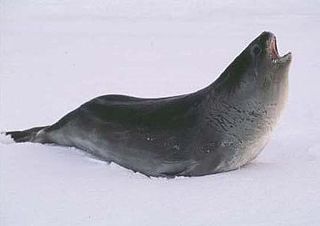
The Ross seal is a true seal with a range confined entirely to the pack ice of Antarctica. It is the only species of the genus Ommatophoca. First described during the Ross expedition in 1841, it is the smallest, least abundant and least well known of the Antarctic pinnipeds. Its distinctive features include disproportionately large eyes, whence its scientific name, and complex, trilling and siren-like vocalizations. Ross seals are brachycephalic, as they have a short broad muzzle and have shorter fur than any other seal.

Antarctica is Earth's southernmost and least-populated continent. Situated almost entirely south of the Antarctic Circle and surrounded by the Southern Ocean, it contains the geographic South Pole. Antarctica is the fifth-largest continent, being about 40% larger than Europe, and has an area of 14,200,000 km2 (5,500,000 sq mi). Most of Antarctica is covered by the Antarctic ice sheet, with an average thickness of 1.9 km (1.2 mi).
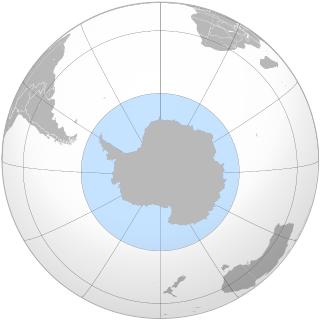
The Southern Ocean, also known as the Antarctic Ocean, comprises the southernmost waters of the world ocean, generally taken to be south of 60° S latitude and encircling Antarctica. With a size of 20,327,000 km2 (7,848,000 sq mi), it is regarded as the second-smallest of the five principal oceanic divisions: smaller than the Pacific, Atlantic, and Indian oceans but larger than the Arctic Ocean.
References
- ↑ Wolfrum, Rüdiger; Bockslaff, Klaus, eds. (1984). Antarctic Challenge: Conflicting Interests, Cooperation, Environmental Protection, Economic Development Proceedings of an Interdisciplinary Symposium, June 22nd-24th, 1983. Institut für Internationales Recht an der Universität Kiel. Vol. 88. Berlin: Duncker & Humblot. p. 99. ISBN 3-428-05540-3.
- ↑ Antonello, Alessandro (2019-07-04), "Arguing with Seals: The Changing Terrain of Authority", The Greening of Antarctica, Oxford University Press, pp. 49–76, doi:10.1093/oso/9780190907174.003.0003, ISBN 978-0-19-090717-4 , retrieved 2023-04-11
- 1 2 3 4 5 6 7 8 9 "Convention for the Conservation of Antarctic Seals (1972)". British Antarctic Survey. Retrieved 2021-08-01.
- ↑ Berta, Annalisa; Churchill, Morgan (2012). "Pinniped taxonomy: review of currently recognized species and subspecies, and evidence used for their description". Mammal Review. 42 (3): 207–234. doi:10.1111/j.1365-2907.2011.00193.x. ISSN 1365-2907.
- ↑ Yonezawa, Takahiro; Kohno, Naoki; Hasegawa, Masami (2009-07-15). "The monophyletic origin of sea lions and fur seals (Carnivora; Otariidae) in the Southern Hemisphere". Gene. 441 (1–2): 89–99. doi:10.1016/j.gene.2009.01.022. ISSN 0378-1119. PMID 19254754.
- 1 2 McCahey, Daniella; Aless; Antonello, ro (2020-11-21). "200 Years Ago, People Discovered Antarctica. The Slaughter Began Soon After". The Wire Science. Retrieved 2021-08-01.
- ↑ Antonello, Alessandro (2019-07-04), "Arguing with Seals: The Changing Terrain of Authority", The Greening of Antarctica, Oxford University Press, pp. 49–76, doi:10.1093/oso/9780190907174.003.0003, ISBN 978-0-19-090717-4 , retrieved 2023-04-11
- ↑ "History of the Convention". Commission for the Conservation of Antarctic Marine Living Resources. 23 October 2019. Archived from the original on 2019-12-05. Retrieved 2021-08-01.
- ↑ "Parties". Secretariat of the Antarctic Treaty. Archived from the original on 2019-09-30. Retrieved 2021-08-01.
- ↑ "Convention for the Conservation of Antarctic Seals". New Zealand Treaties Online. Archived from the original on 2021-03-04.